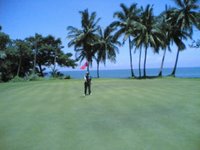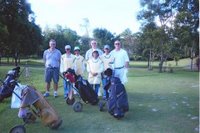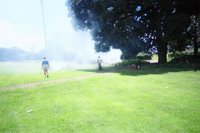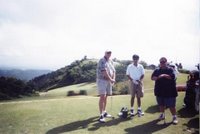
 The golfing experience in the Philippines provides a lot of variety and lot of fun. There are many aspects that make it unique and different from the standard experiences in the US. Most courses are private, and a lot of serious golfers and businessmen have memberships in multiple courses.
The golfing experience in the Philippines provides a lot of variety and lot of fun. There are many aspects that make it unique and different from the standard experiences in the US. Most courses are private, and a lot of serious golfers and businessmen have memberships in multiple courses.

Caddies
The great thing about golf in the Philippines is that all the courses have caddies. The caddies pull the clubs, help with club selection (once they figure out how long a hitter you are), and best of all give advice on how far certain hazards are that you want to avoid and where you should try to hit the ball. Although it helps to have the local knowledge, it is still up to you to make it happen. On the putting greens, they are experts at reading the greens. The greens here can be difficult to read, especially those on the canyon courses where it is hard to get a good feel for horizontal. The reads usually consist of direction and distance you should aim relative to the hole (one grip left) and the speed of the green (fast, medium, regular, slow). More often than not, if you can do what they suggest, you will make the putt or come very close. At some of the older courses the caddies may have 10, 15 or 20 years experience. It is also a good way to learn a few Philippine words: Left-kaliwa, Right-kanan; Water-tubig


Golf courses
Just like everywhere, there is a great range of golf courses in the Philippines. Some are small nine-hole tracks, and some are large, full length 4-course complexes. Most of the courses outside the metro are relatively new (less than 20 years old) and designed by famous course designers like Robert Trent Jones Jr, Jack Nicklaus, Arnold Palmer and others. To the south of the city are many courses built on old sugar plantation land. They can be relatively flat, but have ravines, water, trees and other hazards to make them challenging.
 In this south area is an old 9-hole course called Canalubang Sugar Estate originally built in the 1920’s. It does not have all the modern amenities, and dries up in the summer season, but it is fun to play. It winds itself between two sides of a local village and has a road running across one of the fairways. This same fairway has a church and school along its edge. You may have the opportunity to see goats grazing or the burning of trash along the fairway too. Locals have set up small huts to sell pop and food at strategic spots along the course.
In this south area is an old 9-hole course called Canalubang Sugar Estate originally built in the 1920’s. It does not have all the modern amenities, and dries up in the summer season, but it is fun to play. It winds itself between two sides of a local village and has a road running across one of the fairways. This same fairway has a church and school along its edge. You may have the opportunity to see goats grazing or the burning of trash along the fairway too. Locals have set up small huts to sell pop and food at strategic spots along the course.
 On the top of the Taal Lake Ridge is a course (Tagaytay Highlands) that runs down one of the canyons. The views and vistas on this course are a wonder to behold. One of the holes has a 300-foot drop from the tee box to the fairway in about 100 yards. Other holes cross large ravines or have long downhill fairways. After 9 holes, you are carted back up to the top for the second 9. You can either ride up in a truck, or there is a cable car going from the bottom of the course to the top.
On the top of the Taal Lake Ridge is a course (Tagaytay Highlands) that runs down one of the canyons. The views and vistas on this course are a wonder to behold. One of the holes has a 300-foot drop from the tee box to the fairway in about 100 yards. Other holes cross large ravines or have long downhill fairways. After 9 holes, you are carted back up to the top for the second 9. You can either ride up in a truck, or there is a cable car going from the bottom of the course to the top.The courses are rarely crowded except for early Saturday. The farther from the city you are, the less crowded the courses and less expensive the golf. Also, if the weather looks like it could rain, the courses are pretty empty, especially farther out. Some courses charge as little as $5 for weekdays and less than $10 on weekends. Even very nice courses will only charge between $20 and $30.


Night golf
Because it gets dark so early here (6:30 at the latest) all year round since we are relatively close to the equator, some courses have tried to extend their availability by installing lights, either on the whole course (usually short courses), or the last few holes on the longer courses. The key to night golf (and day golf for that matter too) is to keep it on the fairway, where the lights are. The numerous shadows can make reading the green and putting a bit more of a challenge. It is an enjoyable experience since it is usually cooler and can be a little less windy. Bugs have not been too much of an issue, but the big frogs can come out in large numbers.


Wildlife
I haven’t had the pleasure of seeing any snakes while playing, but one of the groups of people from work that was playing ahead of me at Royale Tagaytay did see a large snake on one of the fairways. It had continued on its way by the time I went through. I have seen a lot of large monitor lizards along the edge of the fairways while playing at Tagaytay Highlands. Usually, you don’t go too far looking for lost balls. The caddies will go looking, and they usually wear long pants. Puerto Azul is one of the courses is known for the monkeys that live in the trees adjacent to the fairway and cross the fairways during play. The time I played there, there were no monkeys out and about.
Coconut break
One of the times we were golfing at Tagaytay Midlands, we were coming down one of the fairways towards the end of the afternoon and came upon some of the maintenance people taking a break and having some fresh coconut milk. One of them had climbed up the tree and kicked down a few coconuts. They then used their machetes to cut the top off. They asked us if we wanted to have some, so we did. It was tasty and cool.
Used balls
Since very few people venture too far off the fairways, there are a lot of lost balls around these courses. There are many locals and employees who go out and hunt down the lost balls and then resell them either on the edge of the course or through middlemen to the courses and pro shops. Most of the balls get sorted and packaged so that you can get a dozen of the same kind of balls. The cost is from $2 to $6 per dozen depending on the brand and whether you are buying direct or “retail”.
No comments:
Post a Comment